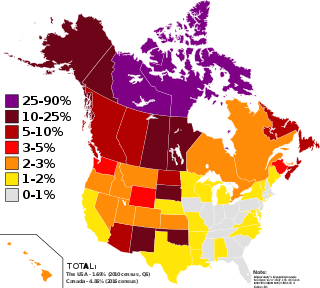Related Research Articles

Indigenous peoples in Canada are the Indigenous peoples within the boundaries of Canada. They comprise the First Nations, Inuit, and Métis. Although "Indian" is a term still commonly used in legal documents, the descriptors "Indian" and "Eskimo" have fallen into disuse in Canada, and most consider them to be pejorative. "Aboriginal" as a collective noun is a specific term of art used in some legal documents, including the Constitution Act, 1982, though in some circles that word is also falling into disfavour.

Inuktitut, also known as Eastern Canadian Inuktitut, is one of the principal Inuit languages of Canada. It is spoken in all areas north of the North American tree line, including parts of the provinces of Newfoundland and Labrador, Quebec, to some extent in northeastern Manitoba as well as the Northwest Territories and Nunavut. It is one of the aboriginal languages written with Canadian Aboriginal syllabics.

Jessie Oonark, was a prolific and influential Inuk artist of the Utkuhiksalingmiut Utkuhiksalingmiut whose wall hangings, prints and drawings are in major collections including the National Gallery of Canada.

Ottawa or Odawa is a dialect of the Ojibwe language spoken by the Odawa people in southern Ontario in Canada, and northern Michigan in the United States. Descendants of migrant Ottawa speakers live in Kansas and Oklahoma. The first recorded meeting of Ottawa speakers and Europeans occurred in 1615 when a party of Ottawas encountered explorer Samuel de Champlain on the north shore of Georgian Bay. Ottawa is written in an alphabetic system using Latin letters, and is known to its speakers as Nishnaabemwin 'speaking the native language' or Daawaamwin 'speaking Ottawa'.

Annie Pootoogook was a Canadian Inuk artist known for her pen and coloured pencil drawings. In her art, Pootoogook often portrayed the experiences of those in her community of Kinngait, in northern Canada, and memories and events from her own life.

Rebecca Belmore is a Canadian interdisciplinary Anishinaabekwe artist who is notable for politically conscious and socially aware performance and installation work. She is Ojibwe and a member of Obishikokaang. Belmore currently lives in Toronto, Ontario.

Pudlo Pudlat, was a Canadian Inuit artist whose preferred medium was a combination of acrylic wash and coloured pencils. His works are in the collections of most Canadian museums. At his death in 1992, Pudlo left a body of work that included more than 4000 drawings and 200 prints.
Olive Patricia Dickason (1920–2011) was a Métis historian and journalist. She was the first scholar in Canada to receive a PHD in Indigenous history. She is known for writing one of the first textbooks about First Nations in Canada, Canada's First Nations: A History of Founding Peoples from the Earliest Times.
Susan McEachern is an American/Canadian artist. McEachern is best known for her photography, which frequently includes text. Her work follows the feminist idea of "the personal is political," as she often combines images of her own life and personal space to investigate and comment on themes of socialization, gender, sexuality, and the natural world. McEachern has also been a professor at the Nova Scotia College of Art and Design University since 1979.

Nadia Myre is a contemporary visual artist from Quebec and an Algonquin member of the Kitigan Zibi Anishinaabeg First Nation, who lives and works in Montreal. For over a decade, her multi-disciplinary practice has been inspired by participant involvement as well as recurring themes of identity, language, longing and loss. Of the artist, Canadian Art Magazine writes, "Nadia Myre’s work weaves together complex histories of Aboriginal identity, nationhood, memory and handicraft, using beadwork techniques to craft exquisite and laborious works."
Skawennati is a Kahnawakeronon multimedia artist, best known for her online works as well as Machinima that explore contemporary Indigenous cultures, and what Indigenous life might look like in futures inspired by science fiction. She served as the 2019 Indigenous Knowledge Holder at McGill University. In 2011, she was awarded an Eiteljorg Contemporary Art Fellowship which recognized her as one of "the best and most relevant native artists."
Nell Tenhaaf is a Canadian artist, teacher, writer and feminist.
Madeleine (Kétéskwew) Dion Stout is a Cree author, speaker, and health care professional. She was appointed to the Order of Canada in 2015.

The Aboriginal Healing Foundation was established in 1998 as an Indigenous managed, non-profit corporation dedicated to responding to the legacy of residential schools in Canada and the associated community health impacts. Funding for the Aboriginal Healing Foundation ceased in 2014.

Ovilu (Oviloo) Tunnillie was born at Kangia, Baffin Island, Northwest Territories and was an Inuit sculptor. Her carvings served as her commentary on both traditional and changing contemporary Inuit culture. She was one of the first Inuit artists to work with an autobiographical theme.

Ulayu Pingwartok was a Canadian Inuk artist known for drawings of domestic scenes and nature.

Heather L. Igloliorte is an Inuk scholar, independent curator and art historian from Nunatsiavut.

Uqqurmiut Centre for Arts & Crafts is an arts centre that was established by the Uqqurmiut Inuit Artists Association in 1990, in Pangnirtung, in the Qikiqtaaluk Region of Nunavut, Canada. The Centre includes a Tapestry Studio, a Craft Gallery, and a Print Shop. In spite of its remote location and small population, numerous Inuit from Pangnirtung have successfully marketed their prints, carvings, sculptures, and textile arts, such as woven wall hangings, to southern collectors. Starting in the 1970s, limited edition prints from the original Print Shop were published annually as the Pangnirtung Prints Collection through the then-Eskimo Co-operative. In 1970 a weaving studio was established and over time the tapestries attracted an international market.

Sarah Lavalley (1895-1991) was a nurse, craftswoman, and community leader from Golden Lake Reserve. In addition to her social work, she is known for supporting cultural exchange between the Indigenous community that she was a part of and non-Indigenous people, as well as supporting cultural continuity through her teaching throughout her life. Lavalley was also known as a skilled maker using traditional patterns and stitching techniques, making wearable crafts like moccasins and mittens for instance.
Elisapee Ishulutaq was a self-taught Inuk artist, specialising in drawing and printmaking. Ishulutaq participated in the rise of print and tapestry making in Pangnirtung and was a co-founder of the Uqqurmiut Centre for Arts & Crafts, which is both an economic and cultural mainstay in Pangnirtung. Ishulutaq was also a community elder in the town of Pangnirtung. Ishulutaq's work has been shown in numerous institutions, including the Marion Scott Gallery in Vancouver, the Winnipeg Art Gallery and the National Gallery of Canada.
References
- 1 2 3 4 Roth, Lorna. "In Memory of Gail Guthrie Valaskakis 1939–2007: A Personal View" (PDF). Canadian Journal of Communication. 32. Retrieved 2014-03-21.
- 1 2 Guthrie, Gail Frances (1964). A study of the theatrical elements in the grand medicine society (Midewiwin) religious cult as practiced by the Northern United States Chippewa Indians. Graduate School of Cornell University.
{{cite book}}: CS1 maint: location missing publisher (link) - 1 2 3 4 "In Memoriam". Concordia University. September 13, 2007. Retrieved December 2, 2016.
- ↑ "Gail Guthrie Valaskakis". Indspire. 20 November 2014. Retrieved December 2, 2016.
- ↑ "Gail Guthrie Valaskakis, Chippewa, 1939-2007" . Retrieved December 2, 2016.
- ↑ Helwig, David (July 6, 2011). "Residential school archive moves to Algoma University". SooToday.com. Retrieved 2017-05-12.
- ↑ Black, Barbara (March 14, 2002). "Gail Valaskakis wins Aboriginal Achievement Award" . Retrieved December 2, 2016.
- ↑ "Gail Guthrie VALASKAKIS". University of Ottawa. Retrieved December 2, 2016.